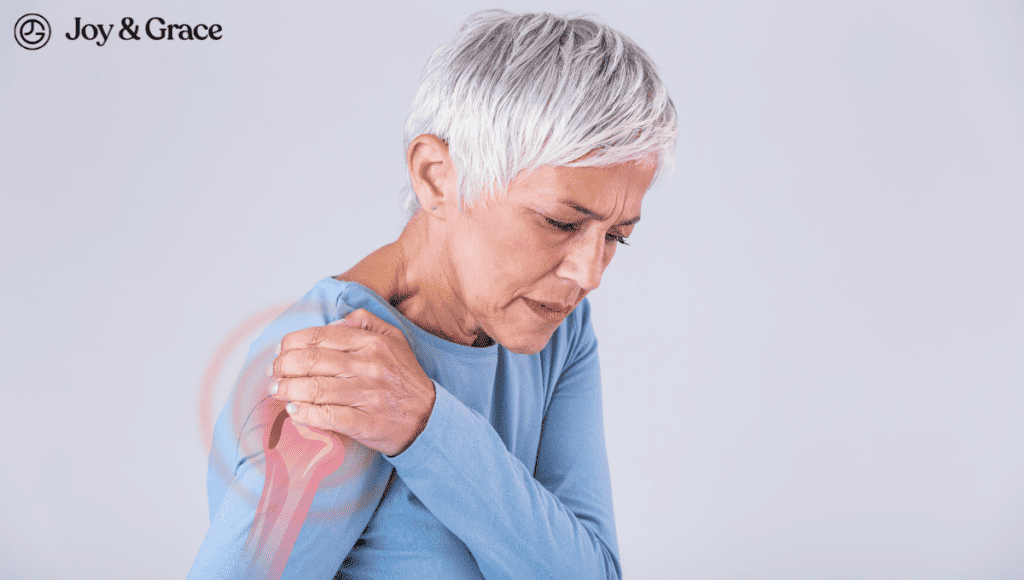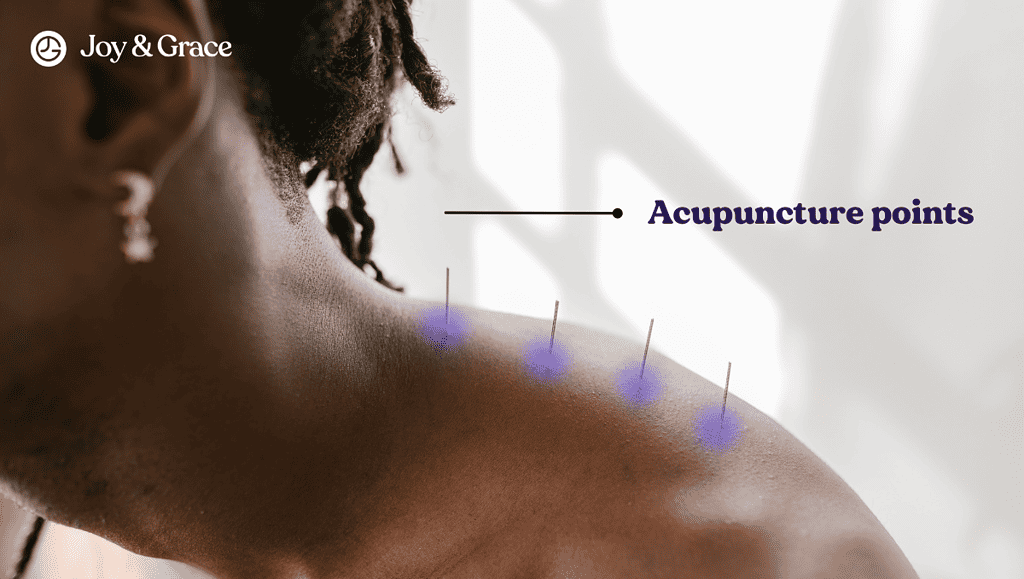Neck pain and meningitis: They go hand in hand… and, more literally, neck and neck.
Neck pain or stiffness is one of the telltale signs of meningitis. Meningitis itself is a problematic condition that may cause dangerous complications.
In this article, we will explain to you where meningitis neck pain is located, what it feels like, and where it spreads. We will also examine the various meningitis symptoms, causes, tests, and treatment methods. Let's dive right in.
Where is Meningitis Neck Pain Located?
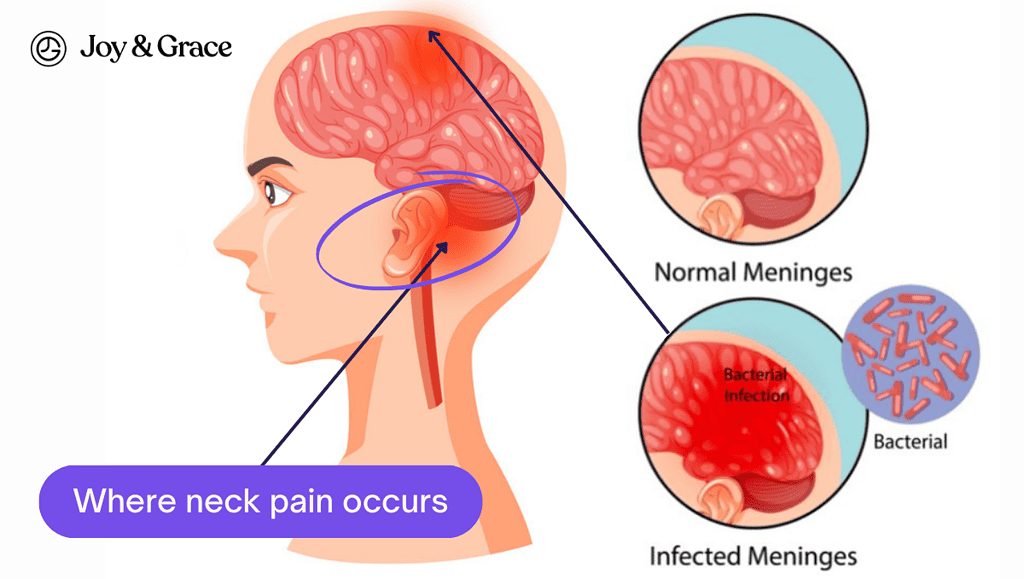
Meningitis neck pain is usually located at the base of the skull, close to the top of the neck.
Meningitis is a disease characterized by inflammation of the meninges. The meninges are three membranes or layers around the brain: the dura (meaning “hard” or “thick”), arachnoid (“spider-like,” due to its appearance), and pia (“tender,” because it’s the thinnest and most delicate out of all the layers).
These membranes reach out from the brain all the way to the neck region, known as the cervical region. The neck region contains a rich network of nerves, blood vessels, muscles, and bones. It is an integral part that connects the head with the rest of the body.
In meningitis, when the neck is flexed, the inflamed meninges of the neck region stretch, causing pain. This also causes the neck muscles to activate and spasm in an attempt to protect the meninges from stretching. The muscle spasm manifests as neck stiffness.
What Does Meningitis Neck Pain Feel Like?
If you suffer from meningitis, your neck feels stiff or rigid. This is why meningitis neck pain is also known as nuchal rigidity. Nuchal means “spinal cord,” depicting that the stiffness originates from one of the layers of the spinal cord (which also surrounds the brain). "Rigid" because the neck moves with difficulty.
When the neck does move, it causes sharp and intense pain. Trying to look up and down exacerbates the pain and stiffness even further. On the other hand, rotating the neck does not worsen the stiffness.
Meningitis neck pain often comes along with headaches as well. Let us find out what these headaches are like.
What Part of the Head Hurts With Meningitis?

Apart from neck pain, meningitis may also cause headaches. The headaches are usually generalized, severe, and develop fast. They are most often dull and throbbing in character. In a case study, about 60% of patients with a meningitis headache described it as "the worst headache of my life."
How Long Does Neck Pain Last After Meningitis?
Meningitis neck pain is almost impossible to live with. But the good news is that, with prompt treatment, your neck pain may be able to get better in two to four weeks. You can notice your neck pain easing off 48 to 72 hours after starting treatment.
If you suffer from meningitis neck pain and other meningitis symptoms, you should see a doctor right away!
Can Meningitis Affect One Side of the Body?
Meningitis usually affects both sides of the brain and body, meaning it is bilateral. You may ask why. Well, the inflammation of the brain membranes that we mentioned earlier is usually diffuse. This means that the inflammation spreads along these membranes. Thus, it is often not located just in one area. When meningitis is bilateral, its symptoms do not pick favorite sides. Instead, they involve your whole body.
In rarer cases, meningitis may affect only one side of the body. This type of meningitis is called “unilateral.”
How Do I Know if My Neck Pain is Meningitis?
By now, you know that a painful, stiff neck is the hallmark of meningitis. But meningitis neck pain is almost always accompanied by other symptoms and signs of meningitis.
Meningitis features depend on your age and immune status. It affects children and adults of all ages. The three classic symptoms of meningitis are:
- Neck pain/stiffness
- Headaches
- Fever
Other common important symptoms and signs that will lead your doctor toward a diagnosis of meningitis include:
- Sensitivity to light or photophobia (bright light is especially problematic in meningitis patients)
- Nausea, vomiting, and diarrhea
- Fatigue
- Rash anywhere in the body
Less common symptoms of meningitis can include the following:
- Agitation
- Decreased alertness and other mental status and neurological deficits
- Bulging fontanelles in babies
- Poor feeding or irritability in children
- Rapid breathing
- Opisthotonos, an abnormal body posture due to the contraction of muscles in the neck, trunk, and lower limbs.
It is important to remember to seek medical attention immediately if your neck pain is accompanied by these symptoms.
How to Tell the Difference Between Meningitis and Normal Neck Pain?
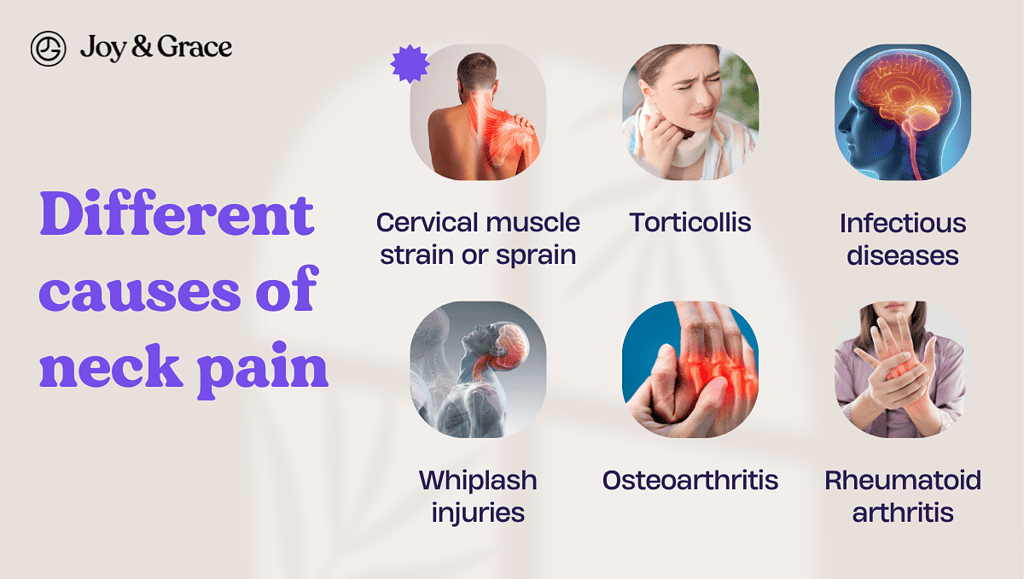
Neck pain may have numerous causes. It can result from:
- Cervical muscle strain or sprain
- Torticollis
- Infectious diseases, such as meningitis
- Whiplash injuries
- Osteoarthritis
- Rheumatoid arthritis, etc.
There are a few giveaways that neck pain belongs to meningitis. Here are the main giveaways for you to consider:
- Neck stiffness: As we mentioned, a stiff neck is a common symptom of meningitis. While regular neck pain can cause stiffness, meningitis-related stiffness is often more severe and may be accompanied by muscle spasms.
- Onset and duration: Meningitis neck pain often occurs suddenly and can be severe. On the other hand, normal or regular neck pain is milder and may develop over time. Additionally, meningitis neck pain typically persists and may worsen over time, while normal neck pain may come and go or improve with rest and/or treatment.
- Pain quality: Meningitis neck pain feels like a sharp, stabbing pain. Neck pain from other causes tends to be a dull ache.
- Other symptoms: Meningitis is associated with a range of other characteristic meningitis symptoms.
What is the First Sign of Meningitis in Adults?
The first signs of meningitis in adults are nonspecific. These include fever, malaise, and headache. Neck pain and the nonspecific symptoms of meningitis are important warning signs of meningitis. They are good reasons for you to think about the possibility of meningitis.
Later on, the irritation of the meninges becomes more pronounced. As a result, the more specific meningitis symptoms that we mentioned develop.
What Causes Meningitis Neck Pain?
As we discussed at the beginning of the article, meningitis neck pain arises from the inflammation of the meninges. This particular inflammation can be caused by infectious or non-infectious processes.
Which Infections Cause Neck Pain?
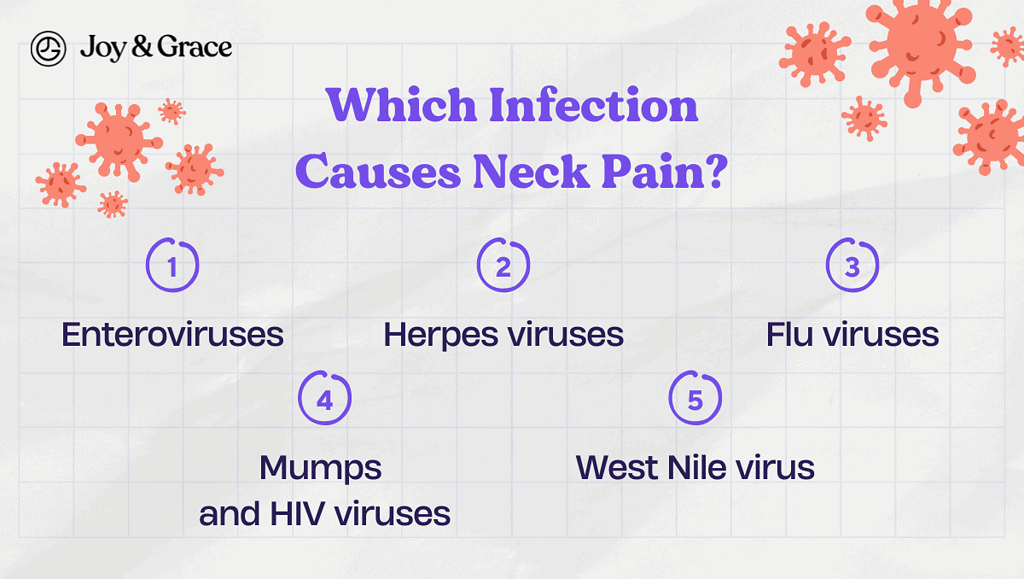
Almost all cases of meningitis are caused by either viral or bacterial infections. How does this happen? Viruses and bacteria can reach the brain membranes by moving into the space between them. This space contains a special type of fluid called cerebrospinal fluid (CSF).
Viral meningitis is the most common meningitis type. Here are some of the main viruses that may cause meningitis:
- Enteroviruses. People get infected with this virus in two main ways. One way is when someone with the virus in their poop accidentally puts their hands in their mouth or touches something you touch later. Then, when you touch your mouth or eat something with your hands, the germs can get inside you and make you sick, too (that’s why washing your hands is so important). Another way is when someone with the germs sneezes or coughs, and little droplets with the germs go into the air. If you breathe in those droplets, the germs can go inside you and make you sick. So, washing your hands and covering your mouth when you cough or sneeze is important to help stop the germs from spreading.
- Herpes viruses. These viruses may also cause less serious changes, like cold sores. They can spread when you touch someone with germs or share things, like drinks, with them.
- Flu viruses. These are especially common infections in children. They can spread when someone sick with the flu sneezes or coughs near you, and you breathe in the germs.
- Mumps and HIV viruses. They can spread when you come into contact with someone's saliva or blood, like when you share drinks or have unprotected sex.
- West Nile virus. This one spreads through mosquito bites. When a mosquito bites someone with the virus, it can bite you and pass the germs to you.
Bacterial meningitis represents about 6 to 18% of all meningitis cases. It most often results from the Streptococcus pneumoniae, Haemophilus influenzae, and Neisseria meningitidis bacteriae. These germs can enter your body when you breathe in tiny droplets from someone who is already sick with them. Bacterial meningitis is the most dangerous meningitis type and consists of a medical emergency. It may lead to life-threatening complications.
Other less common causes of meningitis neck pain are:
- Parasitic and fungal infections
- Drug reactions,
- Autoimmune disorders,
- Cancer or benign, non-cancerous tumors
What Causes Meningitis In Kids?
Meningitis neck pain and stiffness may happen in children of all ages, including infants. The main causes are viral, bacterial, parasitic, or fungal infections. An example of viral infections are respiratory tract infections, such as the flu. Cases of parasitic meningitis and fungal meningitis are rarer.
A child may carry the organism in their nose and throat without showing any symptoms. Similarly to what we explained earlier, these organisms usually spread by:
- Close contact with an infected person
- Touching infected objects (doorknobs, hard surfaces, or toys) and then touching the nose, mouth, or eyes
- Droplets from a sneeze, close conversation, or kissing
How Do I Test for Meningitis Neck Pain?
How do we test for meningitis neck pain? Well, reaching a meningitis diagnosis involves a few steps. Upon visiting your doctor’s office, he will ask you questions about yourself. This means he will take your medical history. Then, he will perform some physical examinations. We will pause here for a bit. What if we told you you could perform these examinations at your own home?
The 3 physical exams for meningeal neck pain and irritation are:
- Nuchal rigidity test,
- Brudzinski’s sign, and
- Kernig’s sign
Let us find out what these tests are and how they are performed.
What is the Nuchal Rigidity Sign?
The Nuchal Rigidity sign or the neck stiffness test is a test used to evaluate meningitis neck pain and stiffness. This test is performed as follows: You lie down on your back with your head on a pillow. The examiner will gently try to move your chin to your chest. If you have meningitis, you show resistance and feel difficulty or pain. In this case, we say that the test is positive.
What is Kernig's and Brudzinski's Sign?
Brudzinski's sign: This test also involves lying on your back. A healthcare provider will lift your head and neck towards your chest. If you have meningitis, your knees will bend involuntarily in response to this movement. A quick reaction like this indicates a positive Brudzinksi sign.
Kernig's sign: This test involves lying on your back with your legs in an extended position. Your examiner will try to lift your leg while keeping your knee straight. If you have meningitis, this movement will be painful and difficult. The presence of pain indicates a positive Kernig’s sign.
What is the Most Accurate Test for Meningitis?
Okay, so the physical exam is complete. What is next? If your doctor suspects meningitis, they may order more accurate tests to confirm the diagnosis.
Your doctor may order an imaging test, such as a CT scan or MRI. These tests can identify if there’s spinal cord or brain swelling and inflammation.
Your doctor may also advise you to perform a lumbar puncture, also known as a spinal tap. A lumbar puncture means inserting a needle into the spinal canal to collect a cerebrospinal fluid (CSF) sample for analysis. This test may detect the presence of bacteria or viruses in the CSF, confirming the diagnosis of meningitis.
You may have to do additional analyses if needed. These include specific analyses, such as blood tests for infectious agents.
How Do I Stop Meningitis Neck Pain?

To relieve meningitis neck pain, your doctor can prescribe you painkillers. Two of the most effective and popular painkillers for neck pain are Tylenol and Advil.
But in order to stop and get rid of the pain for good, you need to follow a specific treatment plan. Your doctor will devise a treatment plan for you based on your medical history and the cause of your condition.
In cases of infectious bacterial meningitis, antibiotics are necessary. The type of antibiotic depends on the organism causing the infection.
Managing meningitis also involves supportive care. Your doctor will make sure to:
- Take care of the airway
- Keep oxygen levels up
- Give adequate fluids through an IV line, and
- Control the fever.
Can I Fully Recover From Meningitis?
If you suffer from meningitis, you should certainly not lose hope. Most people with mild meningitis usually fully recover, although the process may be slow.
If there's a severe infection present, the disease can cause dangerous complications or even fatality. Bacterial meningitis had a 14.3% case fatality rate in the US in 2010.
The most debilitating complications from meningitis include:
- Hearing and/or speech loss
- Blindness
- Permanent nerve and/or brain damage
- Behavioral and cognitive changes
- Loss of muscle control
- Seizures
- Memory loss
These individuals may need long-term medication and supportive care.
Takeaway
Meningitis neck pain is usually located at the base of the skull, close to the top of the neck. Meningitis is a disease characterized by inflammation of the meninges.
If you suffer from meningitis, your neck feels stiff or rigid. Meningitis may also cause headaches. Headaches are mostly dull and throbbing in character.
Meningitis features depend on your age and immune system status. It affects children and adults of all ages. The three classic symptoms of meningitis are:
- A painful and/or stiff neck
- Headaches
- Fever
Almost all cases of meningitis are caused by either viral or bacterial infections.
Other less common causes of meningitis neck pain are:
- Parasitic & fungal infections
- Drug reactions
- Autoimmune disorders
- Tumors
The 3 examinations for meningeal neck pain and irritation are:
- Nuchal rigidity test
- Brudzinski’s sign
- Kernig’s sign
To confirm meningitis, doctors may order:
- Imaging tests, such as CT or MRI
- A lumbar puncture
To relieve meningitis neck pain, your doctor can prescribe you painkillers, such as Ibuprofen. But in order to stop and get rid of the pain for good, you need to follow a specific treatment plan.
In cases of infectious meningitis, antibiotic treatment is necessary.
Most people with mild meningitis usually recover fully. In more serious cases, the disease can cause dangerous complications or fatality.








